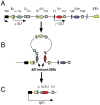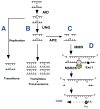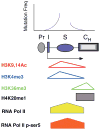Three-dimensional architecture of the IgH locus facilitates class switch recombination
- PMID: 22954221
- PMCID: PMC3442954
- DOI: 10.1111/j.1749-6632.2012.06604.x
Three-dimensional architecture of the IgH locus facilitates class switch recombination
Abstract
Immunoglobulin (Ig) class switch recombination (CSR) is responsible for diversification of antibody effector function during an immune response. This region-specific recombination event, between repetitive switch (S) DNA elements, is unique to B lymphocytes and is induced by activationinduced deaminase (AID). CSR is critically dependent on transcription of noncoding RNAs across S regions. However, mechanistic insight regarding this process has remained unclear. New studies indicate that long-range intrachromosomal interactions among IgH transcriptional elements organize the formation of the S/S synaptosome, as a prerequisite for CSR. This three-dimensional chromatin architecture simultaneously brings promoters and enhancers into close proximity to facilitate transcription. Here, we recount how transcription across S DNA promotes accumulation of RNA polymerase II, leading to the introduction of activating chromatin modifications and hyperaccessible chromatin that is amenable to AID activity.
© 2012 New York Academy of Sciences.
Conflict of interest statement
The authors declare that they have no competing financial interests.
Figures




References
-
- Manis JP, Tian M, Alt FW. Mechanism andcontrol of class-switch recombination. Trends Immunol. 2002;23:31–39. - PubMed
-
- Chaudhuri J, Basu U, Zarrin A, Yan C, Franco S, Perlot T, Vuong B, Wang J, Phan RT, Datta A, Manis J, Alt FW. Evolution of the immunoglobulin heavy chain class switch recombination mechanism. Adv Immunol. 2007;94:157–214. - PubMed
-
- Stavnezer J. Molecular processes that regulate class switching. Curr Top Microbiol Immunol. 2000;245:127–168. - PubMed
Publication types
MeSH terms
Substances
Grants and funding
LinkOut - more resources
Full Text Sources
Other Literature Sources

